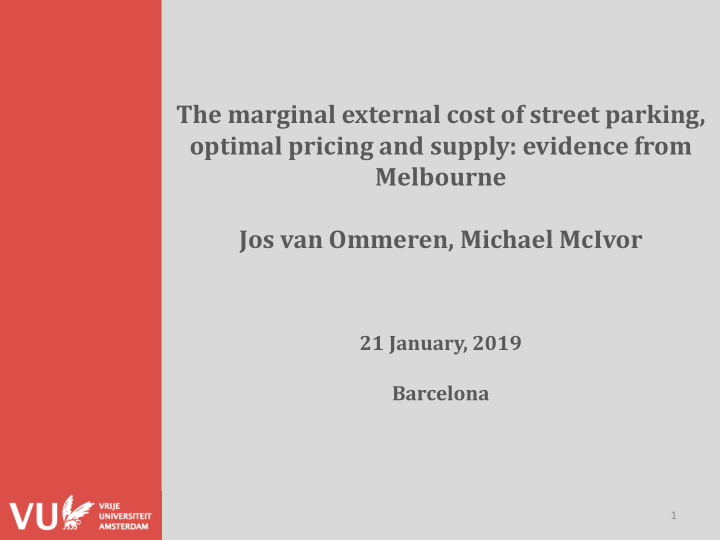



The marginal external cost of street parking, optimal pricing and supply: evidence from Melbourne Jos van Ommeren, Michael McIvor 21 January, 2019 Barcelona 1
1. Introduction parking - On-street parking prices receives a lot of attention in economic theory - We introduce a method to calculate the marginal external cost of parking, i.e. the cruising time costs imposed on other drivers by increasing a parker’s duration - The marginal external cost of parking is important to examine for: - The welfare effects of current parking policy (parking price /time limits) - The welfare effects of changing parking supply - We apply our method to Melbourne 2
Theory: optimal pricing policy - One block, at a particular point in time Demand curve Marginal external cost (occupancy at (extra time/congestion/frustration that price) caused by someone parking) Hourly price (+ restrictions) Economically optimal point 0% 100% Occupancy Underutilisation Cruising problems problems 3 3
2. A model of parking search parking - We aim to derive the marginal external cruising time when one motorist decides to park longer. - Assume that all motorists search in one block following a Poisson process, at time - 𝐵 𝑢 = the number of arriving motorists who search in a block - N = number of parking bays within a block - v(t) = vacancy rate within the block - r = sampling rate of bays - 𝐨 ( 𝑢 )= number of parked motorists 𝑓𝑦𝑢𝑓𝑠𝑜𝑏𝑚 costs = 𝐵 𝑢 - ; 𝑤 𝑢 = 1- 𝐨 𝑢 /N /N 𝐬 𝑤 𝑢 - C(t) = 𝑛𝑏𝑠𝑗𝑜𝑏𝑚 𝑓𝑦𝑢𝑓𝑠𝑜𝑏𝑚 𝑡𝑓𝑏𝑠𝑑 ℎ 𝑢𝑗𝑛𝑓 costs - = 𝝐 𝑓𝑦𝑢𝑓𝑠𝑜𝑏𝑚 costs / 𝝐 𝐨 𝑢 𝐵 𝑢 - C(t) = 𝑠𝑂𝑤 𝑢 2 (Zakharenko, 2016) 4
2. Model parking - We then make assumptions on value of time and search strategy - This provides marginal external cost of parking - One can then examine whether these costs differ from the price of parking - This is important because in the (constrained) optimum, these costs equal the price - One can also calculate now the marginal benefit of increasing supply, because the vacancy rate will go up - The marginal benefit of increasing supply on one day = the sum of all reductions in search cost during the day 5
2. Model parking - We allow for walking time to the final destination - We assume those arriving = number of searchers - We allow for motorists searching in a straight line before they reach the final destination (from an optimally-chosen distance), and searching in a circle on the block after the final destination. - Therefore requires a minimum block size 6
2. Model - As an aside, we show a well-known self financing result - Given optimal policy, the revenue of paid parking = total capital cost on parking - This is useful to say something about whether policy is too strict or too relaxed 7
3. Data and Context parking - We examine parking policy in Melbourne city centre for March 2014 - Maximum parking limits (usually one hour) most of the time - Parking prices far below off-street parking - Sunday parking is free - Evening parking is free without parking limits - Sensor data on arrival rates, occupancy rates - We only have observations when parking limits are in place (typically 07:30 – 20:30) - We focus on about 200 blocks, with a minimum of 10 parking bays - We calculate MEC for 30 min. intervals per block 8
3. Data and Context 9
4. Main results - Cruising times tend to be small - Usually less than two minutes - This is due to low occupancy : - But, when occupancy rates are high, search time is substantial - In 97 percent of the observations, the marginal external cost of parking are small and less than the parking price 10
Cumulative search time parking 11
Distribution of search time, parking for high occupancy rates 12
4. Main results - Marginal external cost of parking also depends on the arrival rate (not just occupancy) - In 97 percent of the observations, the marginal external cost of parking is small and less than the parking price - Due to very restrictive time limits: welfare losses because of that. - When the occupancy rate is above 90%, marginal external costs tends to be substantial - The parking price is too low: welfare losses because of that 13
Marginal external cost of parking parking 14
Main results - Marginal external cost of parking explode Friday and Saturday evenings just before parking becomes free and time limit restrictions do not apply - On Sunday,from 11 to 15 o’clock, marginal external parking cost are substantial (parking is free!) 15
Marginal external cost of parking parking 16
Main results - We calculated the benefits of increasing marginal supply - In the suburbs around the central city, the benefits are much less than the capital (opportunity costs), about $300 per month (derived from the private rental market) - Conditional on current policy (of low prices and harsh time limits), it seems a good idea to reduce supply. 17
Marginal external cost 18
Marginal external cost 19
Marginal external cost 20
Conclusion - We introduce a method to calculate the marginal external cost of parking. - Using data that many parking authorities already have - We examine for Melbourne - The welfare effects of current parking policy (parking price /time limits) - The welfare effects of changing parking supply - During most of the weekdays, time-limit restrictions reduce welfare (i.e., the occupancy rate is too low) - High costs just before time limits expire - On Sunday, substantial marginal external cost 21
Recommend
More recommend